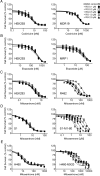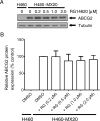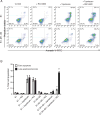Tyrphostin RG14620 selectively reverses ABCG2-mediated multidrug resistance in cancer cell lines
- PMID: 28893612
- PMCID: PMC5634936
- DOI: 10.1016/j.canlet.2017.08.035
Tyrphostin RG14620 selectively reverses ABCG2-mediated multidrug resistance in cancer cell lines
Abstract
The multidrug resistance (MDR) phenotype associated with the overexpression of ATP-binding cassette (ABC) drug transporters ABCB1, ABCC1 and ABCG2 is a major obstacle in cancer chemotherapy. Numerous epidermal growth factor receptor (EGFR) inhibitors have previously been shown capable of reversing MDR in ABCG2-overexpressing cancer cells. However, most of them are not transporter-specific due to the substantial overlapping substrate specificity among the transporters. In this study, we investigated the interaction between ABCG2 and tyrphostin RG14620, an EGFR inhibitor of the tyrphostin family, in multidrug-resistant cancer cell lines. We found that at nontoxic concentrations, tyrphostin RG14620 enhances drug-induced apoptosis and restores chemosensitivity to ABCG2-overexpressing multidrug-resistant cancer cells. More importantly, tyrphostin RG14620 is selective to ABCG2 relative to ABCB1 and ABCC1. Our findings were further supported by biochemical assays demonstrating that tyrphostin RG14620 stimulates ATP hydrolysis and inhibits photoaffinity labeling of ABCG2 with IAAP, and by a docking analysis of tyrphostin RG14620 in the drug-binding pocket of this transporter. Taken together, our findings indicate that tyrphostin RG14620 is a potent and selective modulator of ABCG2 that may be useful to overcome chemoresistance in patients with drug-resistant tumors.
Keywords: ABC transporter; ABCG2; EGFR inhibitor; Multidrug resistance; Tyrphostin RG14620.
Copyright © 2017 Elsevier B.V. All rights reserved.
Conflict of interest statement
The authors declare no conflict of interest.
Figures







Similar articles
-
Dacomitinib antagonizes multidrug resistance (MDR) in cancer cells by inhibiting the efflux activity of ABCB1 and ABCG2 transporters.Cancer Lett. 2018 May 1;421:186-198. doi: 10.1016/j.canlet.2018.01.021. Epub 2018 Jan 11. Cancer Lett. 2018. PMID: 29331420
-
Avapritinib: A Selective Inhibitor of KIT and PDGFRα that Reverses ABCB1 and ABCG2-Mediated Multidrug Resistance in Cancer Cell Lines.Mol Pharm. 2019 Jul 1;16(7):3040-3052. doi: 10.1021/acs.molpharmaceut.9b00274. Epub 2019 Jun 4. Mol Pharm. 2019. PMID: 31117741 Free PMC article.
-
Selonsertib (GS-4997), an ASK1 inhibitor, antagonizes multidrug resistance in ABCB1- and ABCG2-overexpressing cancer cells.Cancer Lett. 2019 Jan;440-441:82-93. doi: 10.1016/j.canlet.2018.10.007. Epub 2018 Oct 10. Cancer Lett. 2019. PMID: 30315846 Free PMC article.
-
Inhibiting the function of ABCB1 and ABCG2 by the EGFR tyrosine kinase inhibitor AG1478.Biochem Pharmacol. 2009 Mar 1;77(5):781-93. doi: 10.1016/j.bcp.2008.11.007. Epub 2008 Nov 18. Biochem Pharmacol. 2009. PMID: 19059384 Free PMC article.
-
Updated chemical scaffolds of ABCG2 inhibitors and their structure-inhibition relationships for future development.Eur J Med Chem. 2022 Nov 5;241:114628. doi: 10.1016/j.ejmech.2022.114628. Epub 2022 Jul 31. Eur J Med Chem. 2022. PMID: 35944339 Review.
Cited by
-
Photothermal release of an encapsulated therapeutic agent from polymer-wrapped gold nanoparticles.Nanoscale Adv. 2021 Jul 2;3(16):4669-4673. doi: 10.1039/d1na00289a. eCollection 2021 Aug 10. Nanoscale Adv. 2021. PMID: 36134313 Free PMC article.
-
ILC2s: New Actors in Tumor Immunity.Front Immunol. 2019 Dec 3;10:2801. doi: 10.3389/fimmu.2019.02801. eCollection 2019. Front Immunol. 2019. PMID: 31849977 Free PMC article. Review.
-
SIS3, a specific inhibitor of Smad3 reverses ABCB1- and ABCG2-mediated multidrug resistance in cancer cell lines.Cancer Lett. 2018 Oct 1;433:259-272. doi: 10.1016/j.canlet.2018.07.004. Epub 2018 Jul 6. Cancer Lett. 2018. PMID: 30026175 Free PMC article.
-
The multi-targeted tyrosine kinase inhibitor SKLB610 resensitizes ABCG2-overexpressing multidrug-resistant cancer cells to chemotherapeutic drugs.Biomed Pharmacother. 2022 May;149:112922. doi: 10.1016/j.biopha.2022.112922. Epub 2022 Apr 5. Biomed Pharmacother. 2022. PMID: 36068781 Free PMC article.
-
Hydroxygenkwanin Improves the Efficacy of Cytotoxic Drugs in ABCG2-Overexpressing Multidrug-Resistant Cancer Cells.Int J Mol Sci. 2022 Oct 23;23(21):12763. doi: 10.3390/ijms232112763. Int J Mol Sci. 2022. PMID: 36361555 Free PMC article.
References
-
- Ahmad SF, Ansari MA, Nadeem A, Zoheir KM, Bakheet SA, Al-Shabanah OA, Al Rikabi AC, Attia SM. The tyrosine kinase inhibitor tyrphostin AG126 reduces activation of inflammatory cells and increases Foxp3+ regulatory T cells during pathogenesis of rheumatoid arthritis. Molecular immunology. 2016;78:65–78. - PubMed
-
- Allen JD, Schinkel AH. Multidrug resistance and pharmacological protection mediated by the breast cancer resistance protein (BCRP/ABCG2) Mol Cancer Ther. 2002;1:427–434. - PubMed
-
- Ambudkar SV. Drug-stimulatable ATPase activity in crude membranes of human MDR1-transfected mammalian cells. Methods Enzymol. 1998;292:504–514. - PubMed
-
- Ambudkar SV, Dey S, Hrycyna CA, Ramachandra M, Pastan I, Gottesman MM. Biochemical, cellular, and pharmacological aspects of the multidrug transporter. Annual review of pharmacology and toxicology. 1999;39:361–398. - PubMed
-
- Ambudkar SV, Kimchi-Sarfaty C, Sauna ZE, Gottesman MM. P-glycoprotein: from genomics to mechanism. Oncogene. 2003;22:7468–7485. - PubMed
MeSH terms
Substances
Grants and funding
LinkOut - more resources
Full Text Sources
Other Literature Sources
Research Materials
Miscellaneous

